Abstract
In the past two decades, particularly through the pandemic, the demand for real-time logistics has significantly increased. Cold chain logistics ensures specific temperature conditions for perishable goods such as food and pharmaceuticals, which is crucial for maintaining product quality, safety, and regulatory compliance. The integration of the Internet of Things (IoT) into cold chain logistics has transformed supply chain operations. The COVID-19 pandemic and the global urgency for vaccine distribution accelerated the adoption of cold chain technologies, emphasizing their role in preserving perishable goods’ integrity. IoT enables real-time monitoring, remote control, predictive analytics, and data-driven decision-making, all of which are essential for modern logistics. We conducted a bibliometric analysis of 50 publications from 1997 to 2024 to examine IoT’s role in cold chain management. Through co-occurrence and co-citation network analysis, core themes, influential works, and major contributors were identified. Thematic mapping highlighted the importance of temperature monitoring, logistics optimization, and risk management. Additionally, the transition from conventional logistics practices to IoT-driven methodologies was investigated in cold chain operations. The findings of this study provide a basis for understanding the structural properties of co-citation and co-occurrence networks in cold chain logistics and the evolving landscape of cold chain technology, and its impact on logistics, emphasizing the importance of intelligent, reliable, and sustainable cold chain systems to meet the growing demands in global supply chains.
1. Introduction
Globalization and the increasing complexity of supply chains have amplified the need for advanced logistics solutions, with cold chain technology emerging as an important research issue. The COVID-19 pandemic disrupted traditional supply chain models, driving a surge in demand for cold chain applications to ensure the quality and safety of perishable goods such as food and pharmaceuticals. This ensures that these goods remain within specific temperature ranges during transportation and storage, preventing quality deterioration. Recent advancements in the Internet of Things (IoT) technology have revolutionized cold chain management, enabling real-time monitoring, remote control, and data-driven decision-making to enhance efficiency and precision in logistics operations [1,2,3].
While the principles of cold chain management have been extensively studied, much of the research focuses on individual technologies or applications. Using bibliometric analysis, the broader knowledge can be explored. Merigó and Yang [4] and Cerchione [5] demonstrated the potential of bibliometric methods to identify research trends, key contributors, and thematic developments. However, a systematic examination of co-citation and co-occurrence networks in cold chain management, especially concerning IoT-driven innovations, remains underexplored. Such a lack of research limits the understanding of how these technologies contribute to supply chain integration and risk management.
This study aims to address the need for a comprehensive analysis of the intellectual structure of cold chain management. By applying the bibliometric method, the essential literature, influential research groups, and key themes were identified to reveal the conceptual evolution of this field. IoT’s role in enhancing supply chain reliability and advancing risk management strategies was also explored [6,7,8,9]. We analyzed journal themes, countries, authors, and keyword hotspots to identify research keywords and collaboration trends. The required features in cold chain management were also identified through co-citation and co-occurrence network analyses.
2. Literature Review
2.1. Cold Chain Technology
Cold chain refers to the temperature-controlled supply chain for maintaining the quality and safety of perishable goods, including food, pharmaceuticals, and vaccines. It ensures the preservation of product integrity during storage and transportation. Recent advancements in cold chain technology, such as energy-efficient sensing methods, have significantly enhanced operational efficiency. For instance, Xiao et al. demonstrated the potential to reduce energy consumption while maintaining optimal storage conditions [2].
2.2. Cold Chain Management
Effective cold chain management ensures that temperature-sensitive products consistently remain within the required temperature ranges, addressing challenges such as inadequate infrastructure in lower-income countries. Brison and LeTallec [3] explored strategies for improving efficiency and reliability in such regions, while Gogou, Katsaros, Derens, Alvarez, and Taoukis [6] highlighted how data-driven approaches optimize operations.
2.3. Bibliometric Analysis in Literature
Bibliometric analysis is a quantitative approach to examining the academic literature, tracking research trends, and identifying influential contributors. Two primary techniques are commonly employed: co-citation analysis, which reveals foundational theories and key studies by examining how often articles are cited together, and bibliographic coupling, which links articles based on shared references, providing insights into research relationships [7,8].
In cold chain management, co-citation analysis has been applied to study the development of critical concepts, such as logistics optimization and risk management [10]. Bibliographic coupling, first introduced by Kessler [8], enables immediate connections between articles. Glänzel and Czerwon [11] studied institutional and regional relationships. This method is used to map the intellectual structure of a field, making it ideal for tracking research developments.
2.4. Co-Occurrence Analysis
Co-occurrence analysis is used to examine the frequency of concepts appearing in the literature to identify emerging themes and research keywords. Lam and Tang [10] utilized this approach to explore the transformative impact of digital technologies such as IoT on traditional cold chains. This method reveals collaboration patterns through co-authorship analysis and tracks thematic developments via keyword co-occurrence [11,12,13,14,15,16]. Recent studies have further extended the use of co-occurrence analysis to address vaccine logistics and cold chain sustainability [17,18], disruptions in food supply chains during the COVID-19 pandemic [19], and consumer adoption behaviors relevant to technological innovations in logistics [20].
3. Research Method
In this study, we evaluated the efficiency, challenges, and innovations in maintaining temperature-sensitive products throughout the supply chain. We analyzed the articles on cold chain management, logistics, and food safety which were published from 1997 to August 2024 to understand the evolution of cold chain management practices and technologies. A list of keywords relevant to cold chain management was created including “cold chain logistics,” “temperature control,” “supply chain efficiency,” “food safety,” “pharmaceutical logistics,” “refrigerated transport,” “sustainability in cold chains,” and “climate impact on cold chains.” The list was modified to remove any irrelevant or outdated articles. Inclusion criteria were established considering empirical studies, reviews, or case studies on cold chain management and temperature-sensitive products (e.g., food, pharmaceuticals, and vaccines). Theoretical articles were excluded. Data including citation counts, publication sources, and author information were collected from the selected articles. Influential authors, highly cited articles, and collaboration patterns among institutions or countries were also identified. The collected data were used to map key articles in cold chain-related research.
Bibliometrics analyses including co-citation, co-authorship, and co-occurrence analyses were conducted to reveal the various aspects of cold chain management. Through co-citation analysis, seminal and highly influential articles were identified based on their citation frequency. Co-authorship analysis was used to highlight collaboration patterns among authors, institutions, and countries and find key authors and research hubs. Co-occurrence analysis was performed to determine keywords in publications to identify emerging research themes, trends, and areas of growing interest. These combined analyses enabled the determination of how subfields, such as food safety and pharmaceutical logistics, interact and contribute to the broader cold chain domain.
R (version 4.3.1) and VOSviewer (version 1.6.19) were used to analyze the collected data and visualize citation networks, thematic maps, keyword clusters, and the intellectual structure of cold chain management. Additionally, using network analysis, the interaction of different subfields (e.g., food safety and pharmaceutical logistics) within the broader cold chain domain was explored. A thematic analysis was conducted to identify key themes, trends, and gaps in related research. Articles were categorized into basic, motor, niche, and emerging themes related to cold chain management. Based on the results, future research directions in cold chain management were proposed in terms of sustainability in cold chain logistics, technological advancements, and the impact of climate change on cold chain operations. The research process is illustrated in Figure 1, which outlines the three-phase methodological flow, including data collection, network construction, and structural analysis.
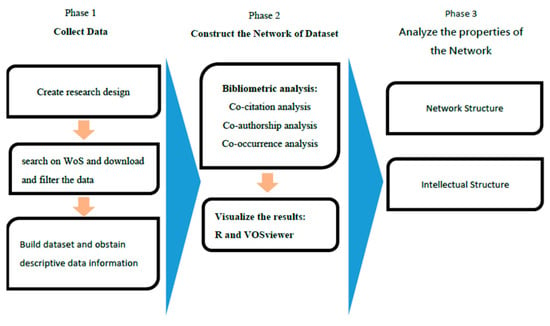
Figure 1.
Research flow in this study.
4. Results
In total, 50 articles from the Web of Science (1997–2024) highlighted key trends in cold chain management research. Figure 2 summarizes the dataset, noting an 8.01% annual growth rate, 22 citations per document, and strong international collaboration (34%). Publication numbers spiked in 2008, 2017, and 2021, reflecting advancements in radio-frequency identification (RFID) technology and the pandemic-driven vaccine distribution. These findings showed trends and intellectual structures. Lam and Tang [10] and Lau et al. [21] discussed the growing focus on technology-driven cold chain solutions.

Figure 2.
Overview of 50 articles from Web of Science.
In total, 50 articles had co-authorship, and 174 authors were identified. By removing authors with zero citations and total link strength, 127 authors with a significant impact were identified. Figure 3 shows the annual publication trend, highlighting notable growth peaks in 2018 and 2023, with 9 articles published in 2023. Figure 4 visualizes a co-authorship network in cold chain management research. Each node represents an author, and different colors indicate 28 distinct groups selected based on collaboration frequency and research similarities. Larger nodes represent authors with more publications or greater influence, while thicker lines show stronger collaborative relationships. Figure 5 shows the nine authors with the strongest collaborative links from the first network. It highlights their tight-knit cooperation as a key figure driving research in cold chain management. The dense connections indicate this group’s significant impact on the field’s academic progress.
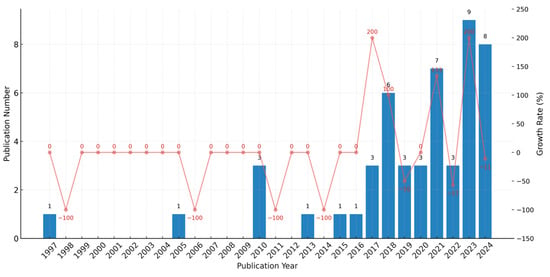
Figure 3.
Annual number of publications and growth rate. Bibliometric Analysis.
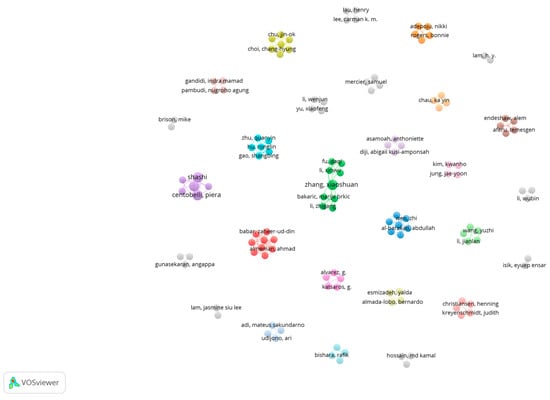
Figure 4.
Co-authorship analysis result (28 clusters of all 127 authors).
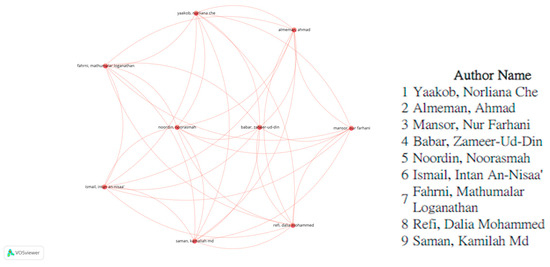
Figure 5.
Co-authorship analysis result (strongest link strength of nine authors).
In total, 79 organizations were grouped into 23 clusters, with the top 5 contributing significantly to cold chain management research in terms of high citations and strong collaborations. The research areas included healthcare, food safety, logistics optimization, and risk management in various regions (Figure 6 and Table 1).
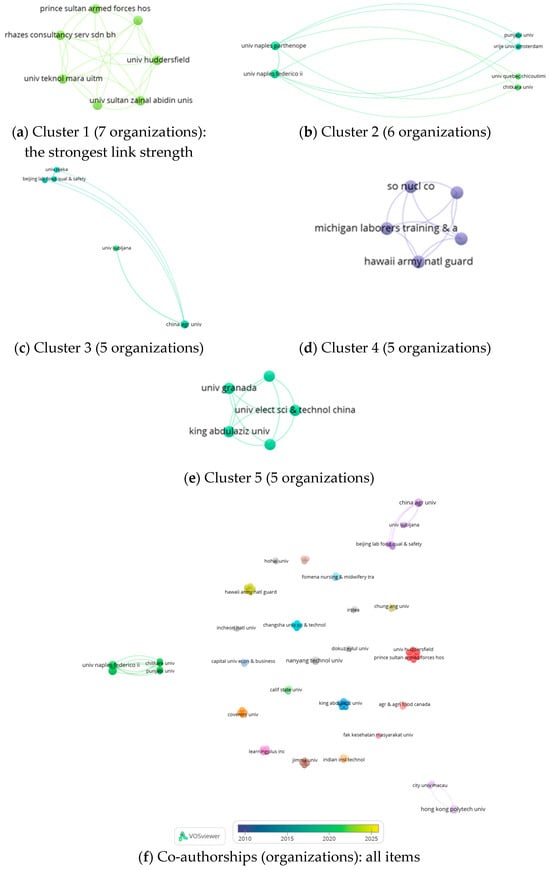
Figure 6.
Co-authorship by organizations (79 items and five clusters of strong total link strength). (a) Cluster 1 (7 organizations): the strongest link strength, (b) Cluster 2 (6 organizations), (c) Cluster 3 (5 organizations), (d) Cluster 4 (5 organizations), (e) Cluster 5 (5 organizations) and (f) Co-authorships (organizations): all items.

Table 1.
Co-authorship by organizations (five clusters of strong total link strength).
The cited sources were analyzed using the fractional counting method. A threshold was set as the minimum number of citations, which resulted in 139 items out of 1137 sources. These 139 items were divided into seven clusters (Figure 7). The result highlighted key focus areas including keywords, niche fields, and interdisciplinary approaches. Key areas included general cold chain management, food science, and health and vaccine logistics (Clusters 1, 2, and 3), while specialized keywords included operations research and decision support systems (Clusters 4 and 5) in cell therapy and public health (Clusters 6 and 7) (Table 2). These clusters underscore the interdisciplinary nature of research, integrating engineering, medicine, computer science, and management. They also revealed research gaps and opportunities, such as decision support systems and logistics adaptation for healthcare, reflecting collaborative and evolving trends driven by technological advancements and global challenges.
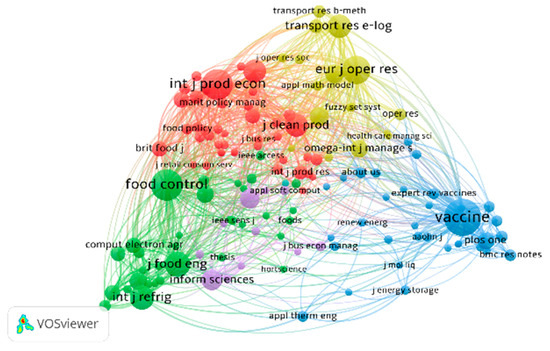
Figure 7.
Cited sources of 139 keywords in seven clusters.

Table 2.
Cited sources of 139 keywords in seven clusters.
A co-occurrence analysis was conducted using keywords, with a minimum occur-rence threshold of 1 and fractional counting. This method enabled a refined analysis by assigning partial credit to each co-occurrence to identify the distribution of keywords. We identified 295 keywords which were grouped into 18 distinct clusters. These 18 thematic clusters in cold chain logistics highlighted key areas including general logis-tics, food safety, healthcare, digital transformation, advanced technologies, and vac-cine logistics (Table 3). The keywords included blockchain, decision-support systems, energy management, and postharvest quality and revealed the interdisciplinary na-ture of cold chain research, emphasizing sustainability, technological innovation, and optimization across supply chain systems. Figure 8 presents the focus areas including general logistics, food safety, healthcare logistics, and digital transformation. Themes included blockchain, decision-support systems, and energy management. The clusters highlighted keywords such as postharvest quality, vaccine logistics, hazard analysis, economic value, and supply distribution systems. The thematic structure in cold chain research emphasized interdisciplinary approaches, technological innovation, and the integration of sustainability and optimization strategies.

Table 3.
The 18 clusters of the 295 keywords.
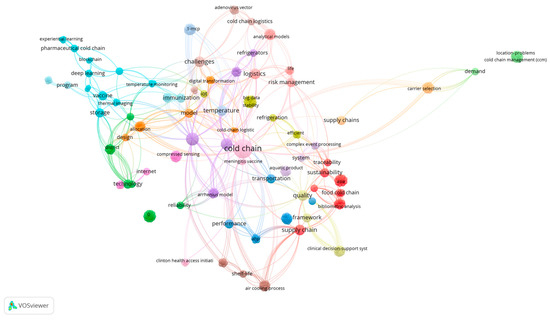
Figure 8.
The 295 keywords in the 18 clusters.
Figure 9 and Table 4 show categorized research keywords into four quadrants which reveal the dynamic research landscape, highlighting key drivers, foundational concepts, and emerging opportunities in cold chain logistics. A two-dimensional thematic map was drawn based on density and centrality to analyze the structure and dynamics of academic fields. The thematic maps and the density-centrality quadrant diagram showed basic themes, niche themes, motor themes, and emerging or declining themes [22]. The theoretical foundation of “co-word analysis” was proposed by Callon et al. [23], who used word co-occurrence to explore thematic structures and interactive relationships and established the data processing logic for quadrant analysis.
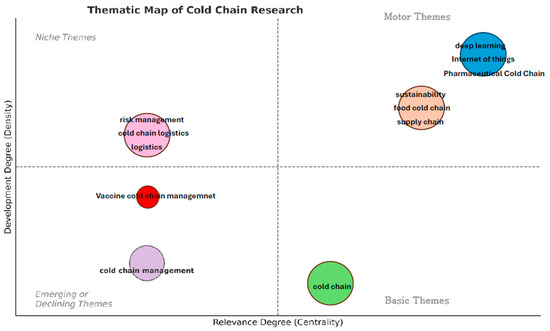
Figure 9.
Thematic map in four quadrants for motor themes, basic themes, niche themes, and emerging or declining themes.

Table 4.
Keywords in four quadrants for motor themes, basic themes, niche themes, and emerging or declining themes.
On the thematic map, cold chain logistics research keywords were grouped into four quadrants: motor themes (e.g., deep learning, IoT, and sustainability) for driving innovation and future advancements; basic themes (e.g., cold chain), which are foundational and central but less complex, supporting deeper exploration; niche themes (e.g., risk management), which are specialized and well-developed but with a limited impact; and emerging or declining themes (e.g., vaccine cold chain management), which are underdeveloped or declining, reflecting new opportunities or reduced interest. The result highlighted the strategic distribution of research areas, revealing driving forces, foundational concepts, and areas for potential growth.
5. Conclusions
We explored co-citation and co-occurrence networks in cold chain management to address gaps in interdisciplinary research. While the existing literature focused on specific technologies, the results of this study provide a basis for understanding the intellectual structure of the networks. Using the bibliometric analysis of 50 publications, key themes, influential research, and collaborative trends were identified. The co-citation analysis result revealed 139 influential keywords in seven clusters, emphasizing interdisciplinary connections between logistics optimization, food safety, vaccine logistics, and technology integration. The co-occurrence analysis result presented 18 thematic clusters, highlighting sustainability, IoT applications, risk management, and blockchain as key areas driving innovation. Collaboration among 127 authors and 79 institutions, particularly in Asia and Europe, focused on healthcare logistics and sustainability. The study results underscore the diversity of cold chain research and the critical role of advanced technologies including IoT and AI in addressing global challenges.
Future research is necessary to explore energy-efficient practices and carbon footprint reduction in cold chain logistics, particularly in the food and healthcare industries. The application of blockchain, IoT, and deep learning for real-time monitoring and risk management across industries also needs to be investigated to strengthen international partnerships and infrastructure and logistics in emerging economies. Adaptable cold chain standards must be formulated for underdeveloped countries to address logistical and economic barriers. By leveraging IoT and AI, real-time operational efficiency in vaccine distribution and food safety can be assessed. Cold chain adaptation to global health supply chains for long-term resilience needs to be executed by integrating technological innovation, sustainability, and global collaboration to develop resilient, energy-efficient, and adaptable cold chain systems. This approach can address evolving challenges and support a globally interconnected supply network.
Author Contributions
Conceptualization, K.-K.L.; methodology, K.-K.L.; software, Y.-J.H.; validation, Y.-J.H., C.-W.H. and K.-K.L.; formal analysis, K.-K.L.; resources, C.-W.H.; writing—original draft preparation, Y.-J.H.; writing—review and editing, C.-W.H.; visualization, Y.-J.H.; supervision, K.-K.L.; project administration, K.-K.L. All authors have read and agreed to the published version of the manuscript.
Funding
This research received no external funding.
Institutional Review Board Statement
Not applicable.
Informed Consent Statement
Not applicable.
Data Availability Statement
The data presented in this study are available upon request from the corresponding author.
Conflicts of Interest
The authors declare no conflicts of interest.
References
- Montanari, R. Cold chain tracking: A managerial perspective. Trends Food Sci. Technol. 2008, 19, 425–431. [Google Scholar] [CrossRef]
- Xiao, X.; Li, Z.; Matetic, M.; Bakaric, M.B.; Zhang, X. Energy-efficient sensing method for table grapes cold chain management. J. Clean. Prod. 2017, 152, 77–87. [Google Scholar] [CrossRef]
- Brison, M.; LeTallec, Y. Transforming cold chain performance and management in lower-income countries. Vaccine 2017, 35, 2107–2109. [Google Scholar] [CrossRef]
- Merigó, J.M.; Yang, J.-B. A bibliometric analysis of operations research and management science. Omega 2017, 73, 37–48. [Google Scholar] [CrossRef]
- Cerchione, R.; Singh, R.; Centobelli, P.; Shabani, A. Food cold chain management: From a structured literature review to a conceptual framework and research agenda. Int. J. Logist. Manag. 2018, 29, 792–821. [Google Scholar]
- Gogou, E.; Katsaros, G.; Derens, E.; Alvarez, G.; Taoukis, P. Cold chain database development and application as a tool for the cold chain management and food quality evaluation. Int. J. Refrig. 2015, 52, 109–121. [Google Scholar] [CrossRef]
- Small, H. Co-citation in the scientific literature: A new measure of the relationship between two articles. J. Am. Soc. Inf. Sci. 1973, 24, 265–269. [Google Scholar] [CrossRef]
- Kessler, M.M. Bibliographic coupling between scientific papers. Am. Doc. 1963, 14, 10–25. [Google Scholar] [CrossRef]
- Zhang, M.; Xia, Y.; Li, S.; Wu, W.; Wang, S. Crowd logistics platform’s informative support to logistics performance: Scale development and empirical examination. Sustainability 2019, 11, 451. [Google Scholar] [CrossRef]
- Lam, H.; Tang, V. Digital transformation for cold chain management in freight forwarding industry. Int. J. Eng. Bus. Manag. 2023, 15, 10. [Google Scholar] [CrossRef]
- Glänzel, W.; Czerwon, H. A new methodological approach to bibliographic coupling and its application to the national, regional and institutional level. Scientometrics 1996, 37, 195–221. [Google Scholar] [CrossRef]
- Leydesdorff, L.; Vaughan, L. Co-occurrence matrices and their applications in information science: Extending ACA to the Web environment. J. Am. Soc. Inf. Sci. Technol. 2006, 57, 1616–1628. [Google Scholar] [CrossRef]
- Callon, M.; Courtial, J.-P.; Turner, W.A.; Bauin, S. From translations to problematic networks: An introduction to co-word analysis. Soc. Sci. Inf. 1983, 22, 191–235. [Google Scholar] [CrossRef]
- Newman, M.E. The structure of scientific collaboration networks. Proc. Natl. Acad. Sci. USA 2001, 98, 404–409. [Google Scholar] [CrossRef] [PubMed]
- Ding, Y.; Chowdhury, G.G.; Foo, S. Bibliometric cartography of information retrieval research by using co-word analysis. Inf. Process. Manag. 2001, 37, 817–842. [Google Scholar] [CrossRef]
- Leydesdorff, L.; Welbers, K. The semantic mapping of words and co-words in contexts. J. Informetr. 2011, 5, 469–475. [Google Scholar] [CrossRef]
- Jiang, S.; Jia, S.; Guo, H. Internet of Things (IoT)-enabled framework for a sustainable Vaccine cold chain management system. Heliyon 2024, 10, e28910. [Google Scholar] [CrossRef]
- Fahrni, M.L.; Ismail, I.A.-N.; Refi, D.M.; Almeman, A.; Yaakob, N.C.; Saman, K.M.; Mansor, N.F.; Noordin, N.; Babar, Z.-U.-D. Management of COVID-19 vaccines cold chain logistics: A scoping review. J. Pharm. Policy Pract. 2022, 15, 16. [Google Scholar] [CrossRef]
- Singh, S.; Kumar, R.; Panchal, R.; Tiwari, M.K. Impact of COVID-19 on logistics systems and disruptions in food supply chain. Int. J. Prod. Res. 2021, 59, 1993–2008. [Google Scholar] [CrossRef]
- Laukkanen, T. Consumer adoption versus rejection decisions in seemingly similar service innovations: The case of the Internet and mobile banking. J. Bus. Res. 2016, 69, 2432–2439. [Google Scholar] [CrossRef]
- Lau, H.; Tsang, Y.P.; Nakandala, D.; Lee, C.K. Risk quantification in cold chain management: A federated learning-enabled multi-criteria decision-making methodology. Ind. Manag. Data Syst. 2021, 121, 1684–1703. [Google Scholar] [CrossRef]
- Cobo, M.J.; López-Herrera, A.G.; Herrera-Viedma, E.; Herrera, F. Science mapping software tools: Review, analysis, and cooperative study among tools. J. Am. Soc. Inf. Sci. Technol. 2011, 62, 1382–1402. [Google Scholar] [CrossRef]
- Callon, M.; Courtial, J.P.; Laville, F. Co-word analysis as a tool for describing the network of interactions between basic and technological research: The case of polymer chemsitry. Scientometrics 1991, 22, 155–205. [Google Scholar] [CrossRef]
Disclaimer/Publisher’s Note: The statements, opinions and data contained in all publications are solely those of the individual author(s) and contributor(s) and not of MDPI and/or the editor(s). MDPI and/or the editor(s) disclaim responsibility for any injury to people or property resulting from any ideas, methods, instructions or products referred to in the content. |
© 2025 by the authors. Licensee MDPI, Basel, Switzerland. This article is an open access article distributed under the terms and conditions of the Creative Commons Attribution (CC BY) license (https://creativecommons.org/licenses/by/4.0/).